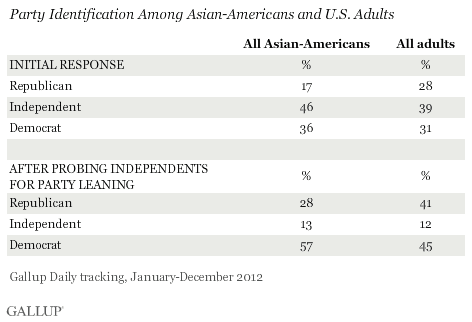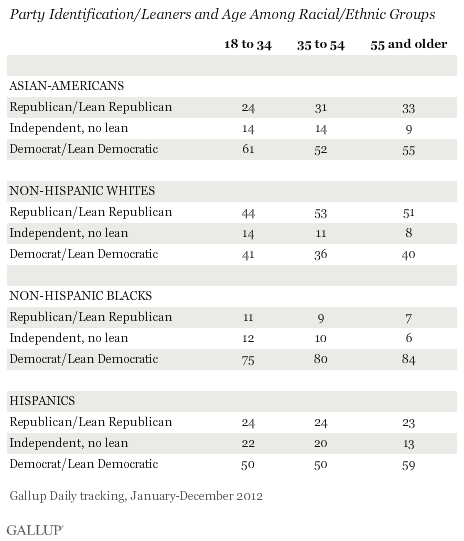WASHINGTON, D.C. -- Asian-Americans -- who were a key part, if sometimes overlooked, of President Barack Obama's 2012 electoral coalition -- solidly back the Democratic Party, with 57% identifying as or leaning Democratic, compared with 28% identifying as or leaning Republican. Thirteen percent are "pure" independents. However, the data suggest that a substantial portion of Asian-Americans are not entirely wedded to either of the major political parties: 46% first describe themselves as independent or other, and only when asked if they "lean" Republican or Democratic does the Democratic Party garner its majority support within this group.

These findings are based on aggregated data from Gallup Daily tracking surveys conducted throughout 2012, including interviews with 6,465 Asian-Americans. For the purpose of this analysis, respondents are categorized as Asian-American if they self-identify their race as Asian.
Republicans did not perform well among Asian-Americans in the 2012 election, losing this group by an estimated 72% to 26% margin. Asian-Americans make up a small but growing portion of the total electorate, probably 3% in 2012. While both parties and the media have focused highly after the election on the similarly Democratically skewed Hispanic vote, these data are a reminder that the Republican Party suffers from a competitive problem with this minority bloc as well.
Older Asian-Americans Slightly More Republican Than Younger Counterparts
While party preferences among Asian-Americans remain oriented toward the Democratic Party across the three major adult age groups -- 18 to 34, 35 to 54, and 55 and older -- the oldest generation of Asian-Americans is somewhat more likely to identify as or lean Republican. One in three Asian-Americans aged 55 and older (33%) do so, while 55% identify as or lean Democratic.

Middle-aged Asians are also more likely to be Republican than their younger counterparts, or compared with the group as whole. In this age group, 31% identify with or lean toward the GOP and 52% with the Democratic Party. However, young Asians break more strongly Democratic, giving President Obama's party a 61% to 24% advantage over the GOP.
This advantage is not to be understated: a commanding 56% of adult Asian-Americans are between the ages of 18 and 34, making Asian-Americans as a whole the youngest of any U.S. racial or ethnic group Gallup analyzes. By comparison, 23% of adult non-Hispanic whites -- the racial category most receptive to the Republican Party -- are between those ages, versus 37% of non-Hispanic blacks and 47% of Hispanics.
The question then for the Republican Party is will young Asian-Americans become, like their older cohorts, more supportive as they age or will they continue their pattern of less support.
Implications
The GOP -- and the media -- has paid a great deal of attention to the party's difficulty in attracting Hispanic electoral support, but the Republican Party also faces considerable hurdles to winning over the Asian-American demographic. This is particularly intriguing because Asian-Americans are more likely to fit the profile of typical Republican supporters in that they have higher incomes than any other racial/ethnic group, including non-Hispanic whites. Nonetheless, Republicans are performing poorly with this group.
Among Asian-Americans aged 18 to 34, this problem is only exacerbated. Democrats are swamping Republicans among this dominant cohort within the Asian-American population, and if this pattern were to continue throughout their lifetimes, the GOP would likely face a structural disadvantage in national elections, especially when combined with the GOP's well-documented difficulties of attracting Hispanic or African-American support. There is, however, reason to suspect that the pro-Democratic sympathies of young Asian-Americans will be tempered a bit as time goes on and perhaps resemble those of older Asian-Americans. Even so, this may be of marginal benefit to the Republican Party due to its current weak standing with Asian-Americans aged 35 or above.
Survey Methods
Results for this Gallup poll are based on telephone interviews conducted Jan. 2-Dec. 30, 2012, on the Gallup Daily tracking survey, with a random sample of 338,703 adults, aged 18 and older, living in all 50 U.S. states and the District of Columbia.
For results based on the total sample of national adults, one can say with 95% confidence that the margin of sampling error is ±1 percentage point.
For results based on the total sample of 6,465 Asian-Americans, one can say with 95% confidence that the margin of sampling error is ±1 percentage point.
Interviews are conducted with respondents on landline telephones and cellular phones, with interviews conducted in Spanish for respondents who are primarily Spanish-speaking. Each sample includes a minimum quota of 400 cellphone respondents and 600 landline respondents per 1,000 national adults, with additional minimum quotas among landline respondents by region. Landline telephone numbers are chosen at random among listed telephone numbers. Cellphone numbers are selected using random-digit-dial methods. Landline respondents are chosen at random within each household on the basis of which member had the most recent birthday.
Samples are weighted by gender, age, race, Hispanic ethnicity, education, region, adults in the household, and phone status (cellphone only/landline only/both, cellphone mostly, and having an unlisted landline number). Demographic weighting targets are based on the March 2011 Current Population Survey figures for the aged 18 and older non-institutionalized population living in U.S. telephone households. All reported margins of sampling error include the computed design effects for weighting.
In addition to sampling error, question wording and practical difficulties in conducting surveys can introduce error or bias into the findings of public opinion polls.
For more details on Gallup's polling methodology, visit www.gallup.com.
